
A parade is a procession of people, usually organized along a street, often in costume, and often accompanied by marching bands, floats, or sometimes large balloons. Parades are held for a wide range of reasons, but are usually some variety of celebration.
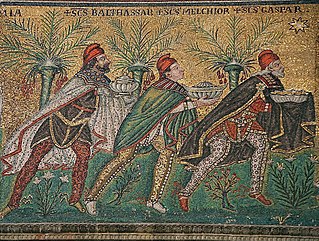
In Christianity, the Biblical Magi, also known as the Three Wise Men, Three Kings, and Three Magi, are distinguished foreigners who visit Jesus after his birth, bearing gifts of gold, frankincense, and myrrh in homage to him. They are commemorated on the feast day of Epiphany—sometimes called "Three Kings Day"—and commonly appear in the nativity celebrations of Christmas.

Santa Claus parades, also called Christmas parades, are parades held in some countries to celebrate the official opening of the Christmas season with the arrival of Santa Claus who always appears in the last float. The parades usually include themed floats, dancing or marching groups and bands playing Christmas songs. They are moving pageants that typically end near the centre of a city. Often sponsored by department stores, they may reinforce the store's brand recognition during the important Christmas shopping season.

The Adoration of the Magi or Adoration of the Kings or Visitation of the Wise Men is the name traditionally given to the subject in the Nativity of Jesus in art in which the three Magi, represented as kings, especially in the West, having found Jesus by following a star, lay before him gifts of gold, frankincense, and myrrh, and worship him. It is related in the Bible by Matthew 2:11: "On entering the house, they saw the child with Mary his mother; and they knelt down and paid him homage. Then, opening their treasure chests, they offered him gifts of gold, frankincense, and myrrh. And having been warned in a dream not to return to Herod, they left for their own country by another path".
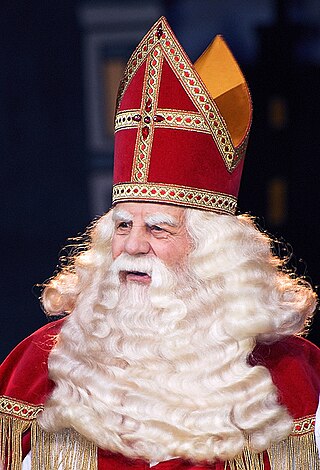
Sinterklaas or Sint-Nicolaas is a legendary figure based on Saint Nicholas, patron saint of children. Other Dutch names for the figure include De Sint, De Goede Sint and De Goedheiligman. Many descendants and cognates of "Sinterklaas" or "Saint Nicholas" in other languages are also used in the Low Countries, nearby regions, and former Dutch colonies.

In Italian folklore and folk customs, the Befana is a witch-like old woman who delivers gifts to children throughout Italy on Epiphany Eve in a similar way to Santa Claus or the Three Magi. The Befana is a widespread tradition among Italians and thus has many names. She is a part of both popular national culture and traditional folk culture and is akin to other figures who roam about sometime during the Twelve Days and reward the good, punish the bad, and receive offerings. The Befana is a mysterious, contradictory figure of unclear origins. This character is enhanced by the fact that she is overall neglected by scholars but is the subject of much speculation by the ones who do mention her. Pre-Christian, Christian, and syncretism of the two have all been postulated as explanations of her origins. In some parts of Italy, especially the central regions, mumming takes place on Epiphany eve. Dolls are made of her and effigies are burnt and bonfires are often lit. She brings gifts to good children, typically sweets, candies or toys, but coal to bad children. She is usually portrayed as a hag riding a broomstick through the air wearing a black shawl and is covered in soot because she enters the children's houses through the chimney. She is often smiling and carries a bag or hamper filled with candy, gifts, or both. She is not only loved but also feared and mocked, particularly by children.

Saint Nicholas Day, also called the "Feast of Saint Nicholas", observed on 6 December in Western Christian countries, and on 19 December in Eastern Christian countries using the old church Calendar, is the feast day of Saint Nicholas of Myra; it falls within the season of Advent. It is celebrated as a Christian festival with particular regard to Saint Nicholas' reputation as a bringer of gifts, as well as through the attendance of church services.

Epiphany, also known as "Theophany" in Eastern Christian tradition, is a Christian feast day commemorating the visit of the Magi, the baptism of Jesus, and the wedding at Cana.

The observance of Christmas around the world varies by country. The day of Christmas, and in some cases the day before and the day after, are recognized by many national governments and cultures worldwide, including in areas where Christianity is a minority religion. In some non-Christian areas, periods of former colonial rule introduced the celebration ; in others, Christian minorities or foreign cultural influences have led populations to observe the holiday.
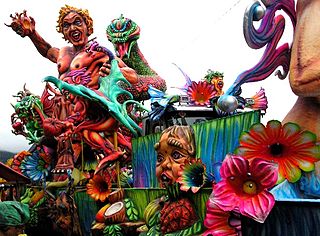
Blacks and Whites' Carnival, is a Carnival public festival and parade in southern Colombia established in 1546. Although its geographical location belongs to the city of Pasto, it has been adopted by other municipalities in Nariño and southwestern Colombia. It is celebrated every year in 2–7 January and attracts a considerable number of Colombian and foreign tourists.

Alcantarilla is a town and municipality in southeastern Spain, in the Autonomous Community of the Region of Murcia. The town is only 7 km away from the capital of the region, the city of Murcia, and one of its peculiarities is that it is completely surrounded by "pedanías" of the municipality of Murcia like Sangonera La Seca, San Ginés, Nonduermas, Puebla de Soto, La Ñora, Javalí Viejo and Javalí Nuevo.

Mardi Gras is the annual Carnival celebration in Mobile, Alabama. It is the oldest official Carnival celebration in the United States, started by Frenchman Nicholas Langlois in 1703 when Mobile was the capital of Louisiana. Although today New Orleans and South Louisiana celebrations are much more widely known for all the current traditions such as masked balls, parades, floats and throws were first created there. From Mobile being the first capital of French Louisiana (1702), the festival began as a French Catholic tradition. Mardi Gras has now evolved into a mainstream multi-week celebration across the spectrum of cultures, becoming school holidays for the final Monday and Tuesday, regardless of religious affiliation.

Chella is a municipality in the comarca of Canal de Navarrés in the Valencian Community, Spain.

Saint Nicholas is a legendary figure in European folklore based on the Greek early Christian bishop Nicholas of Myra, patron saint of children.

A cavalcade is a procession or parade on horseback, or a mass distance ride by a company of riders.
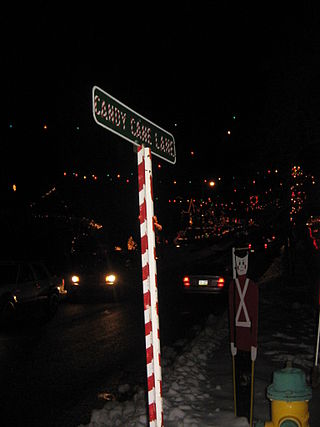
Candy Cane Lane is the name given to the 200 block of Summer Street in Duboistown in the U.S. state of Pennsylvania when it is decorated for Christmas from Thanksgiving to The Epiphany each year. In 2007 Candy Cane Lane celebrated its fiftieth anniversary and was honored with a parade and a proclamation by the mayor of the borough proclaiming the month of "December as Candy Cane Lane month forever more in DuBoistown".

Star singers, also known as Epiphany singers, or Star boys' singing procession (England), are children and young people walking from house to house with a star on a rod and often wearing crowns and dressed in clothes to resemble the Three Magi. The singing processions have their roots in an old medieval ecclesiastical play, centred on the Biblical Magi of the Christmas story in the Gospel of Matthew, appropriate to Epiphany. It is observed usually during the period between 27 December and 6 January.

Christmas in Mexico is observed from December 12 to January 6, with one additional celebration on February 2. Traditional decorations displayed on this holiday include nativity scenes, poinsettias, and Christmas trees. The season begins with celebrations related to the Virgin of Guadalupe, the Patroness of Mexico, followed by traditions such as Las Posadas and Pastorelas.
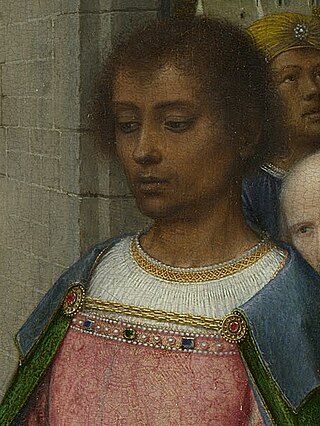
Balthazar, also called Balthasar, Balthassar, and Bithisarea, was, according to Western Christian tradition, one of the three biblical Magi along with Caspar and Melchior who visited the infant Jesus after he was born. Balthazar is traditionally referred to as the King of Arabia and gave the gift of myrrh to Jesus. In the Catholic Church, he is regarded as a saint.





















